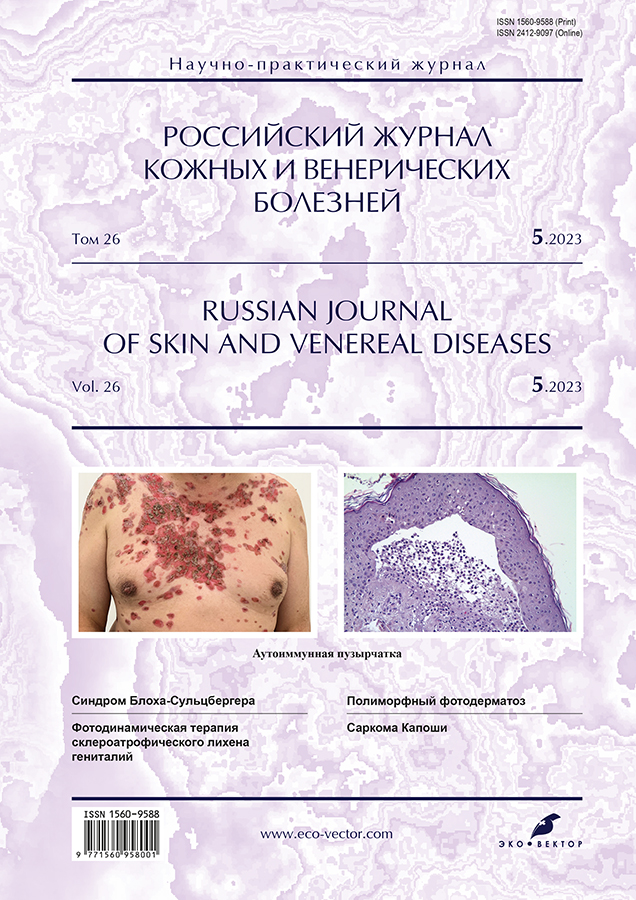Polymorphic photodermatosis as a disease of failed apoptotic clearance in immune-mediated inflammation and the description of a clinical case
- 作者: Selitskaya O.V.1
-
隶属关系:
- Professor V.F. Voino-Yasenetsky Krasnoyarsk State Medical University
- 期: 卷 26, 编号 5 (2023)
- 页面: 507-514
- 栏目: DERMATOLOGY
- ##submission.dateSubmitted##: 08.07.2023
- ##submission.dateAccepted##: 11.09.2023
- ##submission.datePublished##: 17.11.2023
- URL: https://rjsvd.com/1560-9588/article/view/532726
- DOI: https://doi.org/10.17816/dv532726
- ID: 532726
如何引用文章
详细
Polymorphic photodermatosis is the most common, acquired skin disease characterized by an abnormal, recurrent, and delayed response to sunlight.
In this article, modern views on the etiology of pathogenesis are described clinical picture, differential diagnosis, principles of treatment and prevention of polymorphic photodermatosis. The pathogenesis of this disease is a form of delayed-type hypersensitivity reaction to photoantigens. The abnormal immune response has been attributed to the immunosuppressive effects of sunlight due to a breakdown in allergen tolerance and a disruption in the mechanisms of apoptosis.
The main symptoms of the disease are erythema and highly itchy elements of skin lesions, which are very diverse, most often represented by macules, papules and vesicles, or vesiculo-bullous, urticarial, hemorrhagic rashes, hence the name of the disease polymorphic photodermatosis. Usually one morphology prevails in one patient. The article presents a clinical case and the results of their own observations.
Studies of the pathogenesis of polymorphic photodermatosis have confirmed the presence of an abnormal immune response. The exact mechanism of immunosuppression caused by ultraviolet radiation and the relative contribution of UV-B and UV-A in healthy people are still unclear, but the expression of TNF-alpha, IL-4 and IL-10 and the depletion of Langerhans cells appear to be key phenomena.
Diagnosis of the disease based on the clinical picture. The need for differential diagnosis of various forms of polymorphic photodermatosis is due to their clinical and sometimes histological similarity with other skin formations. For more accurate verification of the diagnosis, a biopsy of the examined skin area is possible, followed by histology. The histology of polymorphic photodermatosis is nonspecific, in accordance with the polymorphic clinical picture, as well as depending on the timing of the biopsy.
Further studies of the pathological mechanisms underlying polymorphic photodermatosis may allow us to develop a more targeted approach to conservative treatment and prevention.
全文:
作者简介
Olga Selitskaya
Professor V.F. Voino-Yasenetsky Krasnoyarsk State Medical University
编辑信件的主要联系方式.
Email: Selickaya@inbox.ru
ORCID iD: 0000-0003-3960-1279
SPIN 代码: 1993-5439
MD, Cand. Sci. (Med.), Associate Professor
俄罗斯联邦, 1 P. Zeleznyak street, 660022 Krasnoyarsk参考
- Lembo S, Raimondo A. Polymorphic light eruption: What’s new in pathogenesis and management. Frontiers Med (Lausanne). 2018;(5):252. doi: 10.3389/fmed.2018.00252
- Harwansh RK, Deshmukh R. Recent insight into UV-induced oxidative stress and role of herbal bioactives in the management of skin aging. Curr Pharmaceutical Biotechnol. 2023. doi: 10.2174/1389201024666230427110815
- Vellaichamy G, Chadha AA, Hamzavi IH, Lim HM. Polymorphic light eruption sine eruptione: A variant of polymorphous light eruption. Photodermat Photoimmun Photomed. 2020;36(5):396–397. doi: 10.1111/phpp.12565
- Guarrera M. Polymorphous light eruption. Adv Exp Med Biol. 2017;(996):61–70. doi: 10.1007/978-3-319-56017-5_6.2
- Hiramoto K, Yamate Y, Sugiyama D, et al. The gender differences in the inhibitory action of UVB-induced melanocyte activation by the administration of tranexamic acid. Photodermat Photoimmun Photomed. 2016;32(3):136–145. doi: 10.1111/phpp.12231
- Lembo S, Hawk JM, Murphy GM, et al. Aberrant gene expression with insufficient clearance of apoptotic keratinocytes may predispose to polymorphic light rash. Br J Dermatol. 2017;177(5):1450–1453. doi: 10.1111/bjd.15200
- Licht MK, Nuss AM, Volk M, et al. Adaptation to photooxidative stress: Common and special strategies of the alphaproteobacteria rhodobacter sphaeroides and Rhodobacter capsulatus. Microorganisms. 2020;8(2):283. doi: 10.3390/microorganisms8020283
- Ruksha T, Aksenenko M, Papadopoulos V. Role of translocator protein in melanoma growth and progression. Arch Dermatol Res. 2012;304(10):839–845. doi: 10.1007/s00403-012-1294-5
- Patra V, Mayer G, Gruber-Wackernagel A, et al. Unique profile of antimicrobial peptide expression in polymorphic light eruption lesions compared to healthy skin, atopic dermatitis, and psoriasis. Photodermat Photoimmun Photomed. 2018;34(2):137–144. doi: 10.1111/phpp.12355
- Aksenenko MB, Ruksha TG. Matrix metalloproteinase-9 inhibition and collagen deposition comparative evaluation in various organs. Siberian Med J. 2013;117(2):521–527. (In Russ).
- Kahremany S, Hofmann L, Gruzman A, et al. NRF2 in dermatological disorders: Pharmacological activation for protection against cutaneous photodamage and photodermatosis. Free Radical Biol Med. 2022;(188):262–276. doi: 10.1016/j.freeradbiomed.2022.06.238
- Aksenenko MB, Palkina NV, Sergeeva ON, et al. miR-155 overexpression is followed by downregulation of its target gene, NFE2L2, and altered pattern of VEGFA expression in the liver of melanoma B16-bearing mice at the premetastatic stage. Int J Exp Pathol. 2019;100(5-6):311–319. doi: 10.1111/iep.12342
- Blakely KM, Drucker A, Rosen C. Drug-induced photosensitivity: An update: Culprit drugs, prevention and management. Drug Safety. 2019;42(7):827–847. doi: 10.1007/s40264-019-00806-5
- Millard TP, Bataille V, Snieder H, et al. The heritability of polymorphic light eruption. J Investigative Dermatol. 2000. Vol. 115, N 3. P. 467–470. doi: 10.1046/j.1523-1747.2000.00079.x
- Kadurina M, Kazandjieva J, Bocheva G. Immunopathogenesis and management of polymorphic light eruption. Dermatol Ther. 2021;34(6):15167. doi: 10.1111/dth.15167
- Razeghinejad MR, Torkaman F, Amini H. Blueyellow perimetry can be an early detector of hydroxyl chloroquine and chloroquine retinopathy. Med Hypotheses. 2005;65(3):629–630. doi: 10.1016/j.mehy.2005.04.005
- Thiele JJ, Schroeter C, Hsieh SN, et al. The antioxidant network of the stratum corneum. Curr Problems Dermatol. 2001;(29):26–42. doi: 10.1159/000060651
- Aslam A, Fullerton L, Ibbotson SH. Phototherapy and photochemotherapy for polymorphic light eruption desensitization: A five-year case series review from a university teaching hospital. Photodermat Photoimmun Photomed. 2017;33(4):225–227. doi: 10.1111/phpp.12310
- Sopeña AO, González AA, Ares MP, Gardeazabal GJ. Polymorphous light eruption treated with omalizumab. Photodermat Photoimmun Photomed. 2023;39(1):85–86. doi: 10.1111/phpp.12814
补充文件







